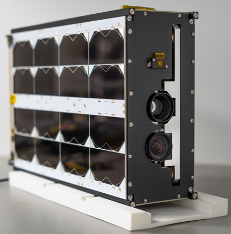HYPSO-1
HYPSO-1
HYPSO-1 is a tiny satellite trying to make big waves in ocean research.
It is a 6U CubeSat developed by the Norwegian University of Science and Technology (NTNU). This miniature satellite, no larger than 6 liters in volume, is equipped with a hyperspectral imager, which lets us observe the world from a new perspective. What sets it apart is its ability to capture visible light and invisible details based on color and in much greater detail than conventional cameras.
Since its launch in January 2022, HYPSO-1 has been on a mission with real-world implications. Its primary focus is on harmful algal blooms, a phenomenon that can disrupt marine ecosystems and pose health risks to humans. By capturing images of the ocean's color in high spectral detail, HYPSO-1 is instrumental in detecting and tracking these blooms early to mitigate their adverse effects.

Here is some of what makes HYPSO-1 such an exciting platform:
- Small but Mighty: Be aware of its size! HYPSO-1's imager can see a range of colors invisible to the naked eye, from violet to near-infrared. Their unique spectral signatures allow scientists to differentiate between healthy and harmful algae.
- Sharp Snapshots: HYPSO-1 can capture images with a resolution close to 150 meters under good conditions. This level of detail allows researchers to narrow down algal blooms' location and extent.
- Speedy Delivery: The design HYPSO-1 allows for quick responses. Unlike larger satellites aiming at global coverage, it can focus on the same area more frequently, providing scientists with closer-to-real-time data on how algal blooms evolve.
- Data on a Diet: Spacecraft have limited bandwidth for sending data back to Earth. HYPSO-1 tackles this challenge with clever onboard processing. It crunches the data on the satellite, keeping only the most crucial information before beaming it down when the mission objectives advocate for doing so.
The HYPSO-1 mission exemplifies miniaturization's power, the space domain's democratization, and intelligent engineering. It paves the way for a new generation of CubeSats to tackle complex scientific challenges in Earth observation.
If you want to learn more about the HYPSO-1 satellite, please follow these links.
- Bakken S, Henriksen MB, Birkeland R, Langer DD, Oudijk AE, Berg S, Pursley Y, Garrett JL, Gran-Jansen F, Honoré-Livermore E, et al. HYPSO-1 CubeSat: First Images and In-Orbit Characterization. Remote Sensing. 2023; 15(3):755. https://doi.org/10.3390/rs15030755
- M. E. Grøtte et al., "Ocean Color Hyperspectral Remote Sensing With High Resolution and Low Latency—The HYPSO-1 CubeSat Mission," in IEEE Transactions on Geoscience and Remote Sensing, vol. 60, pp. 1-19, 2022, Art no. 1000619, doi: 10.1109/TGRS.2021.3080175.
